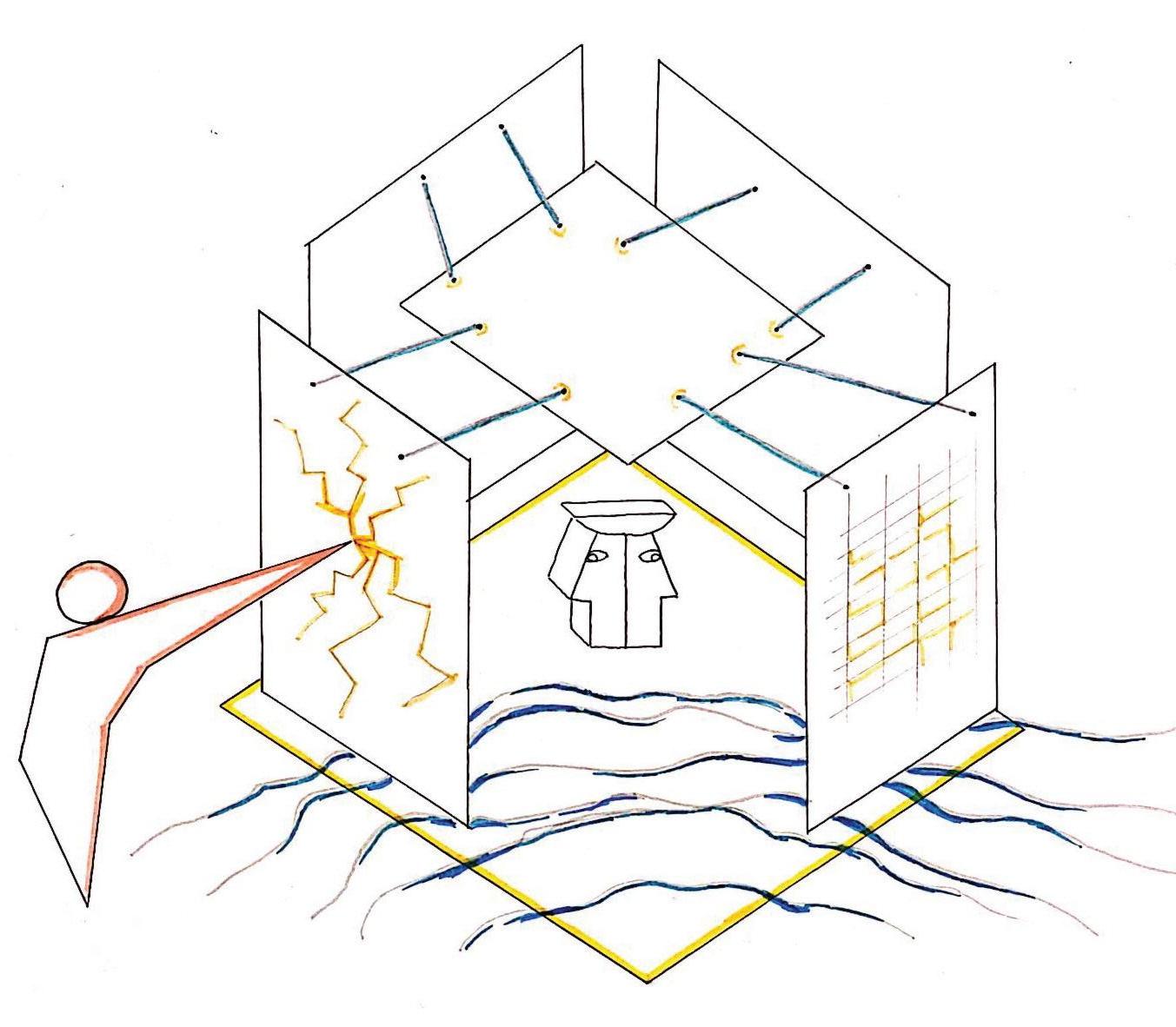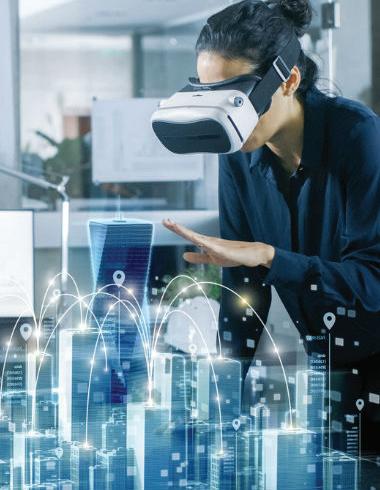
10 minute read
SCENARIO 3 | LIVING LAB
Decentralization of work and life has decreased the city population by over 70% and has resulted in many office and retail buildings being vacant. Cities are re-defining their purpose and are evolving into destinations and innovation hubs with a renewed responsibility to serve citizens and prioritizing developments that improve the quality of life everywhere through conservation, production and sustainability.
Reclaiming spaces and turning them into urban farms is supporting local food production beyond the city with new innovative technologies, creating short distance delivery of produce and promoting healthy living while also addressing food deserts more pervasively throughout the city. The establishment of living labs inspires experimentation with a variety of different food sources and methodologies. It stretches our understanding of what can be considered edible and creates alternative nutritional sources unique to the local environment.
Advertisement
Incubators work at the forefront of developing new scalable solutions to societal problems such as pandemics and climate change destined to replace outdated systems with sustainable solutions utilizing raw and renewable resources. Blocks and urban neighborhoods are networked to share such resources and generate them for each other creating a cyclical economy while also actively contributing to global knowledge sharing and collaboration.
This can be observed in several areas: power and converts it to energy at docking stations, returning it back to the city. Citizens can also choose front of them, making it easier to exercise and travel
GREEN MINDSET
People are mindful about what and how much they consume and how and where it is being produced. The 2020 pandemic has brought into focus, how vulnerable supply chains are, how we are globally connected and that our immediate environment is precious and requires protection.
FOOD EXPERIMENTATION
Urban farms create a connected network among each other, with each farm contributing different types of produce. From fermenting unusual plants, converting foods to local climates, to hydroponics and 3D printing meat, innovation has been promoted to develop ideas and solutions that could be ized communities as well as shared with partners across the world. Due to food production in close range, food is more affordable and in pain view, which has significantly increased overall well-being and healthy lifestyles.
HUMAN-POWERED TRANSPORTATION
An active lifestyle is the focus within car-free cities and exclusively powered by humans such as walking, biking, scooting, skateboarding, and kayaking. Every citizen receives a universal code that can unlock any mobility device from docking stations. Each device also stores the energy created through manvirtual reality glasses that map out our route in widely distributed across the country to decentral
hands-free. These glasses also monitor speed, heart rate, and distance traveled, which can earn you credits to be used in local stores as a currency.
REVERSE HEALTHCARE
Doctors’ offices and hospitals report a decrease in obesity and other diseases. Since environmental factors, work structures, and the built environment have improved, the healthcare system works with a reverse set up where doctors are paid for keeping their patients healthy rather than just treating illnesses. Different schools of thought co-exist and mental health care is completely integrated with regular treatments.
ENTREPRENEURIAL SUSTAINABILITY
Sustainability is front and center across different industries and cities are developing goods such as clothing with locally sourced materials as much as possible. Processes are being simplified allowing individuals to do it themselves and dramatically drop the need for factories. Automation and robotics have enhanced delivery mechanisms connecting these suppliers directly with the customer from delivery drones to robots to pick up stations available on every street corner.
LOCAL GOES GLOBAL AND REVERSE
The development of sustainable solutions is depending on a variety of formal and informal, local as well as geopolitical agendas and interests. Countries across the world have agreed that their cities and governments partner with private enterprises, non-profit organizations and individual citizens rather than imposing top-down solutions. The government supports privately led sustainability efforts through grants and funding to encourage utilization and scalability on a systemic level through knowledge exchanges on a global scale. Companies and citizens are protected from any liability, which ensures that services and innovation can be developed and iterated to benefit society more rapidly.
EDIBLE BUILDING MATERIALS
All buildings have already been converted to being sustainable, net zero, and outfitted with solar panels, harvesting wind or water energy. Active testing of new energy sources and building materials is at the heart of promoting sustainable living concepts. New developments are now built as passive neighborhoods and constructed only with recycled or biodegradable materials, which has led citizens to experiment within local labs and develop new testing environments for materials.
COMMUNITY SERVICE FOR ALL
Every two months the community comes together to clean the public spaces of the city. From landscaping and maintaining green spaces to picking up trash it is expected that every citizen contributes and thus identifies with their living environment. There is a broad system of services people can provide for the community, all of which encourage getting to know each other and to collaborate.
SOCIAL IMPACT EDUCATION
Universities and colleges are offering hybrid and remote options as a standard practice. City and middle spaces serve as an opportunity to congregate and collaborate in person on projects on real local challenges and with local organizations. University campuses are decentralized and offer classrooms everywhere. K-12 schools remain localized and also offer hybrid options to shift towards a more meaningful applied learning model with project-based education tackling local challenges for civic and social impact rather than simply delivering knowledge. Higher Education is made available for all at no or very low cost.

Sketch by: Elisa Elezi 5 26
SCENARIO 4 | HYPER-RESPONSIVE TRANSPARENCY
Technology is present in all aspects of life, personal affairs, work and business as well as politics creating an inclusive environment. The entire globe has access to free internet regardless of income, religion or social affiliation, removing disadvantages of rural or remote areas. Companies and citizen organizations are one and the same distributing new developments evenly. Government is furnished by networks of people and require each business to spend 20% of their revenue towards local and global issues. Instead of leisure being at the forefront of everybody’s aspirations, purpose is the driver of all activities.
Digital innovation to track and collect data points is widespread from wearing personal devices to embedded artificial intelligence in public spaces such as pathways for bikes or pedestrians, in building materials to feed information back to the building’s nerve center, and in locations frequented by citizens to travel, shop, work, or simply engage with each other. The pervasive use of AI is creating hyper-responsive and transformable environments depending on demographics and quantity of citizens present at any given time. In addition, health data can easily be aggregated leading to early detection of citizens carrying contagious diseases, inhaling polluted air or ingesting contaminated water. This provides opportunities for rapid activation of coordinated municipal or city-wide responses.
While digital enhancements are creating a democratization of engagement, they also are increasing concerns about privacy and ethics resulting in discussions and constant negotiation as new technologies are being released.
This can be observed in several areas:
HYPER-RESPONSIVE + TRANSFORMABLE ENVIRONMENTS
Companies are collecting data usage of their prod
Artificial Intelligence is transcending everyday life. Streets and bike lanes work with embedded sensors collecting traffic data, health stats of people utilizing streets, bike lanes, walkways and capture last visited locations to determine movement patterns and type of transportation. Green spaces feature integrated technology responding to quantity and demographic usage. Steps transform into ramps, if senior citizens or individuals in wheelchairs are being detected. Walkways turn into trampolines once
TECHNOLOGY AS EQUALIZER
Governments and companies are working together to provide citizens with the most up-to-date technology for free in regular update cycles. This provides every citizen with the necessary technology to interact and communicate with one another and removes technology from a status symbol to an essential tool to navigate life and work while democratizing the playing field.
DETECTING PATTERNS
kids are in close vicinity. ucts identifying how many strollers, bikes, cars of a certain brand are being used. The kind of sneakers being worn by what demographic and in which parts of the city leads to adjustments of brand positioning. Shopping patterns are being recorded and inform about which demographic or neighborhood is seeking specific services or products, which can lead to conclusions around civic unrest, natural disasters, health issues, or an impending economic crisis.
“GLASS CITIZEN”
Since technology is so pervasive, governments and companies can control and track their citizens. This can pose not only a serious cyber threat on a systems level, but also creates a “glass citizen”. Personal data and information is easily accessible and various personal and public devices and technologies interact with each other 24/7. Ethical issues become more apparent and challenging to balance with the need to stay proactive in the event of major disasters or impeding crisis.
DYNAMIC LIVING ENVIRONMENT
Private homes are defined by spaces that dynamically change depending on usages over the course of day and night and the patterns of their users. Fold away furniture and sliding walls offer flexibility and a customizable set of spaces for life and work. Lighting and temperature regulation react to the users present and their preferences creating individual zones. Houses are self-cleaning and self-disinfecting through UV lights, robotic cleaners reacting to sensors and working as needed. Technology is used to create a clean and natural home environment. Use data including movement patters (which connect to health data) are used to constantly refine performance and comfort provided.
CONNECTED HEALTH MONITORING
Technology has completely deleted the necessity of touching any surfaces or products in the public realm, office buildings, stores, hospitals and nursing homes changing the way we interact with each other and with our environment. People are more antisocial due to less physical interaction and connections being facilitated often through virtual means only. Depression has become a major issue among citizens of all ages. Every household has a personal health robot connected to primary care and specialist offices. Unless a person has a serious illness, it is entirely obsolete to visit doctor’s offices.
GLOBAL OFFICE
The virtual world meshes time and space shifting work significantly. People walk around their global virtual office either from home or their physical local office space stopping by the desk of a colleague in Australia, Europe or Afrika and seamlessly interacting with one another. Virtual reality paired with new AI technologies is the forefront of human sociability, virtual interactions for all purposes are the new normal.
FOCUS ON HUMAN SUPERPOWER
For the last few decades, careers have been focused on the idea of ‘doing’, if you’re not doing something constructive, regardless of the field, then you are failing at life. Automation will cause to shift from the ‘doing’ mentality to one that focuses on thinking instead. Cerebral pursuits will become the norm and will change the way we work and the way we build our careers. As automation and optimization become more prevalent, competencies and skills unique to being human will become more valuable.
INTERCONNECTED EDUCATION
With the ability to access education everywhere and anytime, students can now engage across the world. There is no point to enroll in one single university. Universities have formed massive coalitions, where a university’s survival is contingent on how many students they recruit into the system, how many of their faculty connect with others, how meaningfully they integrate diverse world-wide knowledge, and how many impact points they score. Universities are closely tied to business and industry, embedding practitioners and sharing projects. Not one professor teaches a class, but a fleet of experts across the world are participating virtually to discuss specific subjects.
CONTINUOUS MOBILITY
Autonomous cars and trolley-type vehicles roam constantly up and down each street within a city, which eliminates taxis or the need for any type of public transportation schedule. Magic carpets exist around dense city blocks and in city centers. Smaller electric vehicles are in docking stations all over the city and can be checked out anytime.








